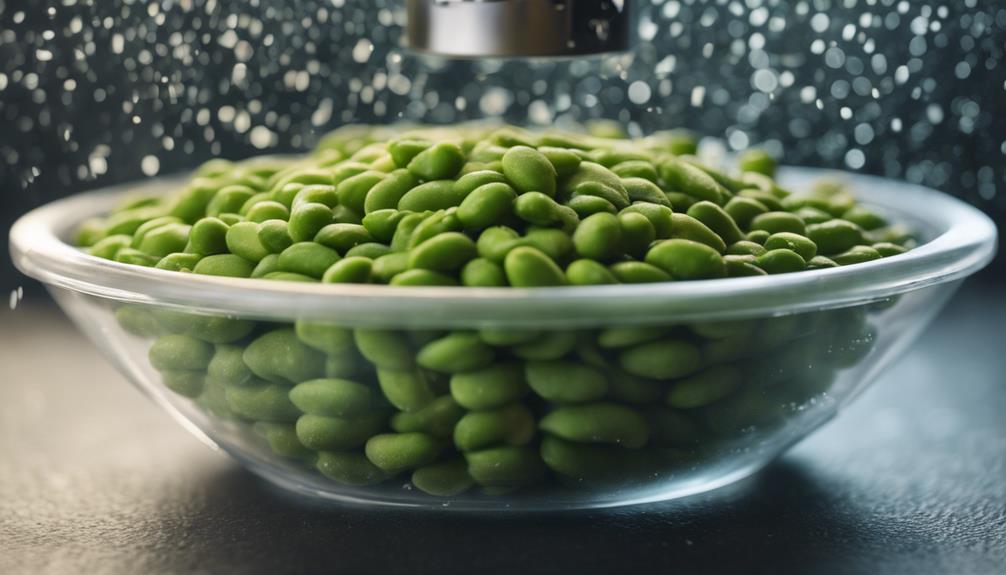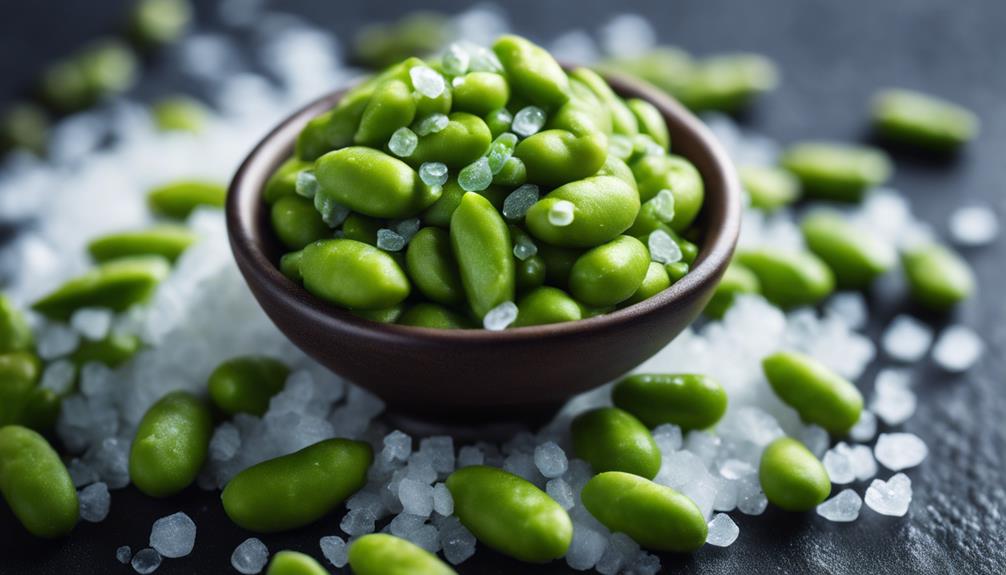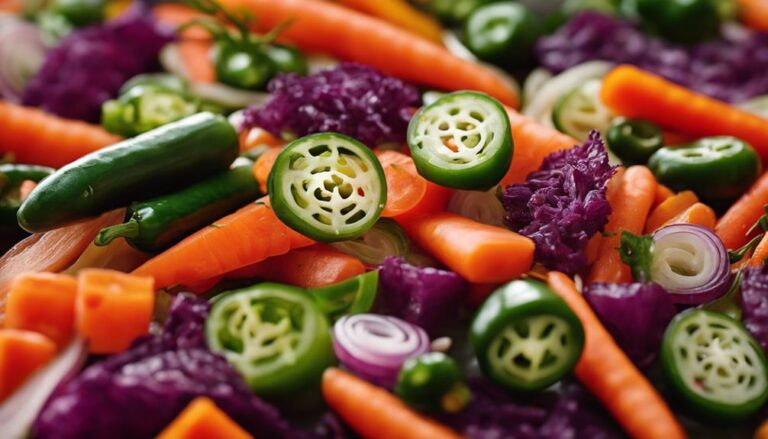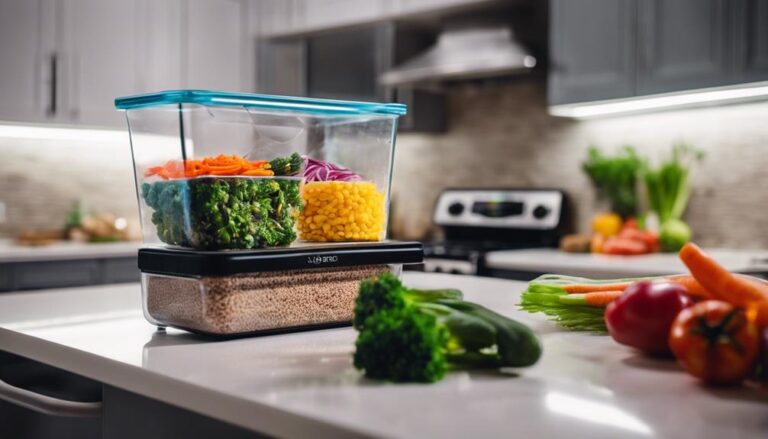Sous Vide Edamame With Sea Salt
Enhance edamame by sous viding with sea salt. Seal pods in bag with salt. Cook in water bath at 185°F for 45 mins. Enjoy the vibrant umami explosion. Feel the burst of freshness!
What You Will Learn Here
- Sous vide cooking enhances edamame flavors and nutrients.
- Sea salt finishing elevates taste and balances flavors.
- Fresh lemon zest adds brightness and complements umami.
- Provides a burst of freshness to the dish.
- Perfect for a protein-packed, flavorful snack.
Origins of Edamame Dish

Edamame originates from Asia, specifically Japan, where it has been a staple dish for centuries. Its rich history and cultural significance contribute to its popularity worldwide.
Understanding the traditional roots of edamame provides insight into its preparation methods and nutritional value.
Edamames Asian Origins
Tracing back through the culinary history of East Asia, the origins of the beloved dish made from young soybeans harvested before full ripening can be found in traditional practices dating back centuries. Edamame, which translates to 'beans on branches' in Japanese, has been a staple in Asian cuisine for generations.
These tender beans are commonly boiled or steamed, then served with sea salt or other seasonings, creating a simple yet flavorful snack or appetizer. Edamame's Asian origins showcase the region's deep-rooted appreciation for wholesome, plant-based foods that not only satisfy hunger but also provide essential nutrients like protein, fiber, and antioxidants.
This traditional dish has transcended borders, engaging taste buds worldwide with its health benefits and delicious taste.
Health Benefits Overview
In discovering the health benefits behind the origins of this traditional Asian dish, one can appreciate the nutritional value that edamame brings to the table. Edamame is an excellent source of plant-based protein, fiber, vitamins, and minerals, making it a wholesome addition to your diet. Below is a table highlighting some key nutrients found in edamame:
| Nutrient | Benefits |
|---|---|
| Protein | Supports muscle growth |
| Fiber | Aids digestion |
| Vitamins | Boosts immune function |
| Minerals | Essential for body functions |
Cooking Methods Comparison
Exploring the historical methods of preparing the edamame dish reveals a nuanced comparison of cooking techniques employed in its traditional origins.
Boiling and steaming are the two primary methods used for cooking edamame, both known for their easy application and ability to preserve the natural flavors of the soybeans. Boiling edamame in salted water is a quick method that allows the beans to cook evenly and absorb flavors, while steaming retains more nutrients and can enhance the texture.
The choice between these methods often depends on personal preference and desired outcomes. Regardless of the method chosen, the simplicity of cooking edamame highlights its versatility as a snack or appetizer, making it a popular choice for those seeking a nutritious and delicious option.
Edamame Preparation Essentials

Are you maximizing the flavor and texture of your edamame by following these essential preparation steps? To make sure your edamame is at its best, be sure to:
- Cook Properly: Whether steaming or boiling, cook your edamame beans for 4-5 minutes to achieve the ideal texture.
- Blanch Effectively: After cooking, blanch the edamame beans in cold water. This process helps to lock in their crunchiness, providing a delightful contrast to the soft interior.
- Season Thoughtfully: Enhance the natural flavors of edamame by seasoning with sea salt. The coarse texture and organic taste of sea salt complement the edamame perfectly, elevating its overall taste profile.
Edamame Variations to Try
You can elevate your edamame game by trying out exciting variations like Edamame With Spicy Garlic Butter, Sesame Ginger Glazed Edamame, and Tangy Wasabi Edamame Recipe.
These inventive twists will add a burst of flavor and creativity to your edamame dishes, making them a standout snack or side dish.
Experimenting with different flavor profiles will keep your taste buds intrigued and your meals interesting.
Edamame With Spicy Garlic Butter
Enhance the classic edamame dish by infusing it with a spicy garlic butter that elevates the flavors to a new level of indulgence. Here's how to create this delicious variation:
- Prepare the Edamame: Start with a base of perfectly salted edamame, blanched to preserve its vibrant color and nutrients.
- Make the Spicy Garlic Butter: Combine melted butter with minced garlic and a touch of red pepper flakes for a kick of heat.
- Toss and Enjoy: Toss the edamame in the spicy garlic butter mixture, ensuring each bean is coated evenly. Serve hot and watch as your guests delight in the savory, spicy goodness of this elevated edamame dish.
Sesame Ginger Glazed Edamame
For a sophisticated twist on traditional edamame, consider trying the flavorful Sesame Ginger Glazed Edamame recipe. This variation combines the nutty essence of sesame oil with the vibrant kick of ginger, creating a unique and elevated flavor profile for your edamame. The glaze adds depth and complexity, enhancing the overall taste experience and transforming this simple snack into a gourmet delight. By infusing your edamame with the delicious Asian-inspired fusion of sesame and ginger, you're sure to impress your guests with a dish that's both familiar and novel. Elevate your edamame game with this delightful recipe that promises to tantalize your taste buds.
- Combines nutty sesame oil with zesty ginger.
- Glaze adds depth and complexity.
- Elevates the simple snack into a gourmet experience.
Tangy Wasabi Edamame Recipe
Experimenting with bold flavors, the Tangy Wasabi Edamame Recipe offers a spicy twist to the classic edamame snack. When preparing this dish, you can expect a tangy and spicy kick that elevates the traditional edamame experience. Here's how to make it:
- Prepare the Wasabi Mixture: Mix edamame with a generous amount of wasabi paste for a unique flavor combination.
- Enhance with Coarse Sea Salt: Sprinkle some coarse sea salt over the edamame to add a contrasting texture and enhance the overall taste.
- Serve and Enjoy: Present this dish as a flavorful appetizer or snack option for those seeking a different taste experience with a hint of heat and zing.
Give this recipe a try to infuse your edamame snack with a burst of exciting flavors!
Edamame Blanching Technique
When blanching edamame, remember to keep the process quick to preserve their crunchiness.
Retaining the vibrant green color of the beans is essential for an appealing presentation.
Proper blanching techniques help maintain the natural flavors of edamame.
Quick Blanching Process
To guarantee perfectly cooked and vibrant green edamame, the blanching process requires boiling the beans for approximately 5 minutes. This quick blanching technique helps to soften the beans while preserving their color and nutrients.
After boiling, promptly remove the edamame from the water to prevent overcooking. Once blanched, generously sprinkle sea salt over the edamame to enhance its flavor profile.
Serve the blanched edamame immediately, offering soy sauce for dipping on the side to complement the nutty taste of the beans. This precise blanching method guarantees that your edamame is tender, flavorful, and visually appealing, ready to be enjoyed as a delightful snack or appetizer.
Retaining Vibrant Green
Blanching edamame is an important step in preserving its vibrant green color and ensuring ideal texture, especially when starting with frozen edamame. The blanching technique involves quickly boiling the edamame for a short period and then immediately cooling it in ice water. This process helps retain the vibrant green hue of the beans while also preserving their natural crunchiness.
Preserving Natural Flavors
For vital maintenance of the natural flavors in edamame, utilize a quick blanching technique in boiling water to sustain the vibrant green color and enhance the overall texture and taste of the beans.
Blanching edamame beans not only helps maintain their natural flavors and nutrients but also guarantees that they stay crunchy and fresh.
By rapidly blanching the edamame in boiling water, you can soften the outer pod, making it easier to enjoy the delicious beans inside.
This process is essential for improving the overall texture and taste of the edamame, providing a more enjoyable culinary experience.
Final Thoughts
In conclusion, integrating sous vide cooking into your edamame preparation routine can enhance the flavors and nutritional value of this protein-packed snack.
When finishing your sous vide edamame with sea salt, consider adding a hint of fresh lemon zest to elevate the dish further.
The addition of lemon zest can provide a bright and citrusy note that complements the natural umami flavors of the edamame.
This final touch not only adds a burst of freshness but also contributes to the overall balance of flavors in the dish.
Frequently Asked Questions
Is Edamame With Salt Good for You?
Salt intake matters for your health. Edamame with salt is a good choice in moderation. It provides potassium, fiber, and essential nutrients. Balancing electrolytes, it contributes to your well-being. Enjoy it as a flavorful and nutritious snack.
Do You Have to Cook Frozen Shelled Edamame Before Eating?
Yes, you should cook frozen shelled edamame before eating for safety and taste. Cooking enhances edamame benefits by softening the beans and making them enjoyable. Boil or steam them to make sure they're safe and delicious to eat.
Is It Better to Steam or Boil Edamame?
When deciding between steaming or boiling edamame, consider nutrient retention and texture preferences. Steaming retains more nutrients, while boiling is quicker. Choose based on your desired texture and convenience. Both methods are acceptable for cooking edamame.
How Do You Eat Salted Edamame?
To enjoy salted edamame, simply squeeze the beans out of the pods with your fingers. The salt enhances their natural flavors. Get creative with recipes like edamame hummus or stir-fried edamame with garlic and chili for a delicious twist!
Conclusion
Overall, sous vide edamame with sea salt is a simple yet flavorful dish that highlights the natural sweetness and crunch of edamame. By using the sous vide method, you can perfectly cook the edamame to retain its vibrant green color and nutrients.
Experiment with different seasonings and variations to create your own unique twist on this classic dish. With a little practice and attention to detail, you can elevate your edamame game to impress even the most discerning palate.











